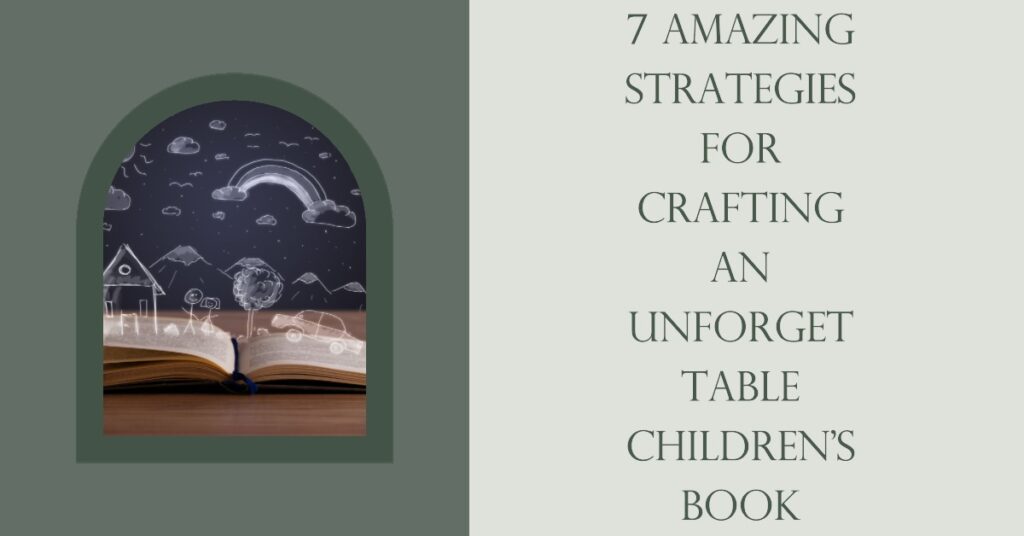Kids’ story books are a great way to express your creative ideas. However, writing a children’s book is challenging and requires a lot of creativity, imagination, and dedication. A great children’s book is entertaining but also educational and inspiring.
It should have a memorable storyline, relatable characters, engaging illustrations or imagery, and a strong message that resonates with young readers. In this article, we will explore 7 amazing strategies for crafting an unforgettable children’s book that will captivate the hearts and minds of kids.
Get the Best Idea
Getting the best idea is crucial to creating a successful and unforgettable children’s book. Your concept should engage and excite young readers while being relatable and educational. There are several ways to generate ideas for your children’s book.
You can utilize the stories you loved as a child, the games you played, your adventures, the lessons you learned, and the challenges you faced to inspire you and your book. Additionally, you can also look to the world around you for inspiration. Consider the natural world, cultural events, or historical figures. Look for interesting stories, fascinating characters, and unique settings that can inspire your own story.
Work on the Main Character
Creating a compelling main character is essential to the success of your book. The main character is the heart and soul of your children’s book. They are the ones who will take readers on an unforgettable journey and help them learn valuable lessons along the way.
Your character should be unique and have a distinct voice that sets them apart from others in children’s books. Consider their motivations, fears, and dreams, and ensure young readers can relate. A well-developed main character is essential to creating an unforgettable children’s book. By giving your character a unique personality, relatable traits, and a memorable appearance, you can help young readers connect with your story and keep them engaged from beginning to end.
Determine the Right Length
Determining the right length for your children’s book is crucial to keeping young readers engaged. Picture books for young children should be short and simple, with a word count of around 500-1000 words.
Early reader books can be slightly longer, with a word count of up to 3000 words. In comparison, middle-grade novels for older children can be longer and more complex, with a word count of 30,000 to 50,000 words. It’s essential to keep in mind the attention span of your target age group and ensure that your book is the appropriate length to hold their interest.
Jumpstart Your Story
Jumpstarting your story is crucial to grabbing young readers’ attention and keeping them engaged. The beginning of your book should hook the reader and draw them in with vivid imagery and descriptive language. The middle of your story should keep them on the edge of their seat with exciting action and conflict.
Finally, the end of your story should provide the reader with a satisfying resolution and closure. By focusing on these key elements, you can create a compelling and unforgettable story that will keep young readers engaged from beginning to end.
Pinpoint the Main Point
Pinpointing the main point or message of your children’s book is essential to creating a meaningful and impactful story. The message should be clear and easy to understand, and it should align with the age group you are targeting.
Your message should also be relatable to young readers and reflect their experiences or struggles. Consider what you want your readers to take away from your book and ensure your story supports this message. By creating a strong and impactful message, you can help young readers learn valuable lessons and develop important skills that will benefit them throughout their lives.
Pick a Captivating Book Title
Picking a captivating book title is crucial to catching the attention of potential readers and getting them interested in your story. A great title should be memorable and descriptive, giving young readers and their parents a hint of what to expect from your book. Use wordplay, puns, or descriptive language to make your title stand out. Make sure the title of your book is age-appropriate and reflects the tone and style of your book.
Keep in mind that a great title can make all the difference in whether or not your book gets noticed, so take the time to brainstorm and come up with something unique and catchy. It’s also a good idea to research and see what titles have worked well for similar books in your genre. By picking a captivating title, you can pique readers’ interest and encourage them to pick up your book and give it a read.
Hire a Skillful Editor
Hiring a skillful editor is essential in creating a polished and professional children’s book. An editor can provide valuable feedback and suggestions to help you refine your story. And make it more engaging and age-appropriate. They can help you fix any errors, check for consistency. And ensure that the pacing and structure of your book are on point. A skilled editor can also provide valuable feedback on your characters. Helping you develop them further and making them more relatable to young readers.
It’s important to find an editor with experience working on children’s books and who understands this genre’s unique challenges and requirements. A good editor should be able to communicate clearly and work collaboratively with you to bring your vision to life. By hiring a skilled editor, you can ensure that your children’s book is of the highest quality and will be well-received by young readers and their parent
In conclusion, writing a great children’s book requires a lot of hard work, creativity, and dedication. By following these 7 amazing strategies, you can craft an unforgettable book to entertain, educate, and inspire young readers. Don’t forget to consider Kids Book Writing Services as a way to get professional help with your book. With the right idea, characters, length, and message. You can create a book that will be cherished by kids for years to come.

